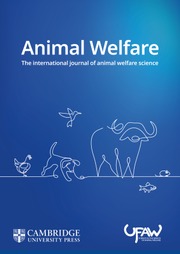Article contents
Welfare of Male and Female Broiler Chickens in Relation to Stocking Density, as Indicated by Performance, Health and Behaviour
Published online by Cambridge University Press: 11 January 2023
Abstract
The purpose of this experiment was to provide information relevant to the current debate concerning the optimisation of terminal stocking density for commercial broiler production. In a modern, controlled-environment house with 24 floor pens (each 11.4 m2), 4020 day-old broilers (Ross 308) were allocated to three terminal (42 days) stocking densities (28, 34 and 40 kg m-2) x two sexes x four replicates, according to a randomised block design. Group sizes varied from 130 to 208. Husbandry conditions were in accordance with normal commercial practice. Performance and behaviour were measured systematically during each of the six weeks of life, and additional measurements were made of leg health and litter condition. Data were analysed using ANOVA to determine the effects of stocking density, sex and age. The realised mean terminal stocking densities were 28.2, 33.5 and 38.5 kg m2. The main significant effects of stocking density treatment were a linear decline in food intake with increasing density during week six (the final week), and a reduced proportion of time spent panting deeply during weeks five and six at the lowest density. Increased (shallow and deep) panting shown by females in weeks two to five suggests that if thermal discomfort becomes a problem at higher stocking densities later in the growing period, it may do so earlier in females. There was no conclusive evidence from this study that broiler welfare is compromised any more at 40 than at 34 kg m−2. The fact that the proportion of time spent panting deeply in week six was considerably lower at 28 kg m2 than at 34 and 40 kg m−2 suggests that thermal comfort (and hence welfare) at this age may be improved at densities of less than 34 kg m−2. However, the significant effects of age, age x density, and age x sex on time spent panting deeply suggest that the age at slaughter and the sex of birds in single-sex flocks should be taken into account in future considerations of optimal maximum terminal stocking density.
- Type
- Research Article
- Information
- Copyright
- © 2002 Universities Federation for Animal Welfare
References
- 46
- Cited by


